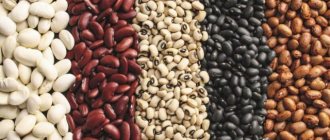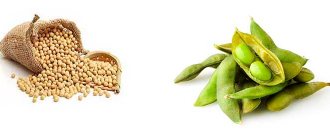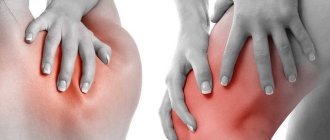Hello friends!
Today I want to talk about such an important microelement as magnesium and what foods contain magnesium in good quantities.
And in general, about why our body needs this microelement so much, what is the role of magnesium in the human body and what can happen if we don’t have enough of it.
Believe me, the information is very important, and I think it will be useful to you.
Importance of Magnesium for Health
Magnesium plays an important role in ensuring the proper functioning of the athlete’s body:
- Participates in the formation of bone tissue.
- Ensures proper muscle contraction, incl. and hearts. A long-term lack of magnesium is fraught with the deposition of salts in the muscles and also negatively affects blood vessels.
- Participates in metabolic processes: absorption of vitamins, transport of chemicals, protein synthesis, breakdown of carbohydrates and conversion of glucose into energy.
- Provides the passage of nerve impulses.
- Participates in the removal of toxins from the body.
- Provides restoration of strength, prevents general fatigue, muscle weakness and muscle cramps.
The importance of magnesium for the body, video clip:
About Magnesium
Daily norm
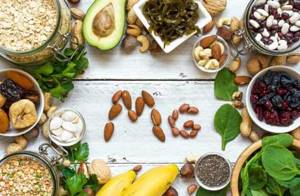
The recommended magnesium intake for women is approximately 300 mg, and for men - 400 mg per day. Magnesium requirements increase by approximately 150 mg during exercise, pregnancy and breastfeeding.
| Age | Magnesium norm per day, mg |
| 1-3 | 80 |
| 4-8 | 130 |
| 9-13 | 240 |
| 14-18 | 360 |
| 19-30 (women) | 310 |
| 19-30 (men) | 400 |
| Women over 30 | 320 |
| Men over 30 | 420 |
Absorption of magnesium by the body
The absorption of magnesium by the human body has its own nuances:
- Vitamin B6 improves the absorption of magnesium by the intestines, ensures its penetration and fixation inside the cells of organs and tissues.
- Magnesium is best absorbed from organic compounds, for example, salts of lactic or aspartic acids (magnesium lactate and citrate). Inorganic salts (common magnesium sulfate) are poorly absorbed.
- The absorption of magnesium is impaired by excess calcium, phosphorus, potassium, sodium, and fats in the body. You should also not abuse caffeine and alcohol.
- Many tasks involving magnesium in the body are performed in conjunction with vitamins D and C.
Where does magnesium come from and how much is needed?
Despite this high importance, our body does not know how to produce magnesium on its own - we get it from food. Women 19 years of age and older need Magnesium to stay healthy. Fact Sheet for Health Professionals 310 mg of magnesium per day (pregnant women - up to 350 mg), men under 30 years old - 400 mg, over 30 years old - 420 mg.
An alternative is to get magnesium from multivitamins and supplements. However, in this case there is a risk of overdoing it. An excess of magnesium manifests itself as nausea, stomach cramps, diarrhea, and in some cases can lead Magnesium and Your Health to cardiac arrhythmia and even cardiac arrest.
Therefore, do not take magnesium supplements under any circumstances if you have:
- heart problems;
- renal failure;
- intestinal obstruction;
- myasthenia gravis.
Regular food is a much safer way to get your daily dose of magnesium. Even if you eat too many foods that contain this mineral, your kidneys will eliminate the excess through urine. And you will get nothing but benefit.
Magnesium rich foods
The table shows a list of foods with the highest calcium content.
| Products | Magnesium content (mg/100 g) |
| Wheat bran | 611 |
| Pumpkin seeds | 534 |
| Sesame seed | 351 |
| Almond | 304 |
| Pine nuts | 234 |
| Peanut | 185 |
| Walnuts | 169 |
| Spinach | 87 |
| Beans | 63 |
| Dried dates | 59 |
| Sunflower seeds | 58 |

Igor May 21, 2016
Products are leaders in magnesium content
The largest amount of magnesium is found in plant foods. Meat, chicken eggs, and dairy products contain very little of this macronutrient. From 100 g of beef or pork you can get only 3 - 5% of the daily requirement. The same applies to dairy products. Daily norms are:
- children 1 - 3 years old - from 60 to 150 mg;
- 4 - 6 years - 150 - 200 mg;
- over 7 years - 250 mg;
- teenagers under 18 years of age need a large amount of the mineral - from 360 to 410 mg;
- adults - from 300 to 500 mg, depending on gender and physical activity.

The ranges of the daily norm for children are explained by the fact that it is calculated depending on the child’s body weight. 6 mg of mineral is required per 1 kg of weight.
Table: magnesium content in 100 g of products.
| Products | Macronutrient amount | Percent of daily requirement for an adult (based on a daily value of 400 mg) |
| Sesame | 540 mg | 135% |
| Watermelon seeds | 515 mg | 128,8% |
| Wheat bran | 448 mg | 112% |
| Cocoa | 425 mcg | 106,3% |
| Cashew | 270 mg | 67,5% |
| Pine nuts | 251 mg | 62,8% |
| Almond | 234 mg | 58,5% |
| Soybeans | 226 mg | 56,5% |
| Buckwheat | 200 mg | 50% |
| Peanut | 180 mg | 45,5% |
| Brown rice | 177 mg | 44,3% |
| Kelp | 170 mg | 42,5% |
| Hercules | 129 mg | 32,3% |
| Walnuts | 120 mg | 30% |
| Prunes | 102 mg | 25,5% |
| Dried porcini mushrooms | 102 mg | 25,5% |
| Parsley | 85 mg | 21,3% |
| Sprouted wheat grains | 82 mg | 20,5% |
| Spinach | 82 mg | 20,5% |
| Wheat bread with bran | 80 mg | 20,3% |
| Dill | 70 mg | 17,5% |
| Dates | 69 mg | 17,3% |
| Halibut | 60 mg | 15% |
| Persimmon | 56 mg | 14% |
| White beans | 51 mg | 12,8% |
| Hard cheeses | 50 mg | 12,5% |
| Barley grits | 50 mg | 12,5% |
| Arugula | 47 mg | 11,8% |
| Bananas | 42 mg | 10,5% |
| Raisin | 42 mg | 10,5% |
The list of products can be continued, but the magnesium content in them will be insignificant. What is indicated in the table is quite accessible both in terms of availability in stores and in price.
With the help of a properly formulated diet, you can fully satisfy the body's need for magnesium without resorting to the help of synthetic drugs.
Products for blood vessels and heart
Magnesium in combination with potassium is vital for the heart and blood vessels. The podium for products that lead in the content of these macroelements is given to:
- legumes and dried apricots - first place;
- the second place is taken by seaweed;

- on the third - beans.
The combination of two macroelements protects the heart from arrhythmia, lowers blood pressure, makes you physically stronger, makes it easier to bear heavy loads and relieves fatigue.
Products for men's health
To maintain sexual activity, a man needs more than just magnesium. Zinc and selenium should be present in his food daily. Zinc deficiency threatens a decrease in potency, and selenium deficiency threatens a deterioration in sperm quality. Magnesium, in turn, helps prevent prostate cancer, normalizes the state of the nervous system and the emotional background.

Champions in magnesium and zinc content:
- watermelon seeds;
- peanut;
- sesame;
- sprouted wheat.
Magnesium in combination with selenium can be found in foods:
- soya beans;
- wheat bran;
- oatmeal and rice;
- seeds and nuts.
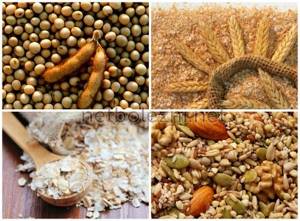
In the combination of magnesium and zinc, optimal mineral balance is achieved in the presence of calcium. Minerals in this combination have a joint balanced effect on the body.
Magnesium, when combined with zinc and calcium, can interfere with the absorption of iron, so foods high in magnesium and iron should be consumed at different times.
Magnesium and pregnancy
When a woman is pregnant, her body's need for vitamins and minerals increases sharply. During this period, he needs a maximum daily dose of magnesium - 500 mg. Since it is one of the “antagonists” of iron, the diet should be formulated so that the two important elements do not “interfere” with each other.
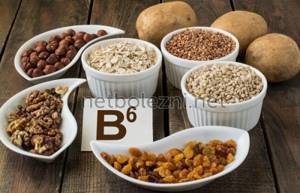
Porridges that are beneficial for pregnant women include buckwheat, millet, oatmeal, and seaweed. They successfully combine magnesium and potassium. You need to include more greens in your diet, replace regular bread with bran bread. It is better to prefer halibut as a fish - it contains a lot of this mineral. It is found in almost all vegetables and fruits in larger or smaller quantities. It is difficult to meet the daily macronutrient requirement of pregnant women with food alone, so women are additionally prescribed magnesium supplements.
What foods contain magnesium?
You can find out which foods contain magnesium from sources describing recipes for dietary nutrition. This does not mean that the element is only found in dietary products. Man eats plant foods and animal products.
Many of them contain the necessary microelement with a slight difference: more or less. Not all vegetarian foods contain magnesium.
Products of plant origin

To determine which plant foods contain magnesium, it is suggested to consider some of them. The category of cereals and grains includes wheat, bran, rice cereals (different varieties), buckwheat, and oatmeal.
Selected from the nut family: walnuts, almonds, peanuts, pine nuts, cashews
Magnesium is present in abundance in legumes, dried fruits, vegetables (raw) and herbs: green peas, lentils, beans, potatoes, spinach, apricots, dried apricots, avocado, soybean oil, soy sauce, cauliflower. Pumpkin seeds and sunflower seeds are also rich in magnesium.
Animal products
Which animal products contain magnesium can be clearly seen from the fish and meat foods listed below:

- oysters;
- lobster;
- crab;
- shrimps;
- flounder;
- halibut;
- perch;
- beef;
- chicken meat (breast);
- chicken eggs;
- pork.

With correct consumption of the listed plant and animal products, you can compensate for the lack of microelements in a short time.
Foods containing large amounts of magnesium
All of the above foods included in your daily diet contain enough magnesium to support the body.
Almost all ingredients contain the element: in the fruit or vegetable juice you drink, in the breakfast or lunch you eat. Among magnesium-containing products, there are products that have the largest supply of the microelement.
Vegetable oils
- sesame oil;
- soybean oil;
- almond oil (more than in the nut itself);
- linseed oil.
Seafood
Among seafood, one of the first places in microelement content is occupied by:
- mussels;
- squid.
Fruits and dried fruits
A special place in the composition of the element is given to:
- avocado (maximum micronutrient);
- apples (recommended with peel);
- peaches (use with peel);
- dried apricots;
- prunes.
Cereals
Among grains and cereals, the highest percentage of magnesium is found in:
- bran (wheat and rice);
- oatmeal;
- buckwheat;
- brown rice
Read the popular article in the category: An effective drug - Exoderil varnish for nail fungus. Reviews, price.
Certainly. There's not a lot of information online, you can find a guy who says "cacao keith" and his blogs have information, but not much.
I had to try it offline to find out. A nomadic Mexican couple introduced me to cacao ceremonies. First of all, let me say that the ceremonies surrounding cocoa go back a long time, but their specificity has largely been lost. We just know that they are centered around opening the heart. The details of modern cocoa ceremonies are thus left almost entirely to the discretion of those who compose them. Unfortunately, this can sometimes mean that he is overtaken by whites, yuppies, "hippies" trying to align their chakras. Luckily, I've only heard about this online and haven't experienced it in person.
The cacao ceremonies I've been to either have a great respect for history or intentionally use it as a healing practice, as meditation. In those I follow, we try to seek healing from an agnostic point of view.
As for the ceremony itself, you need to prepare the so-called “chocolate drink”. What you can do is add a pound of cocoa to a cooker with just under a gallon of water so that 1 ounce of cocoa is in 8 ounces of liquid. You can also add cayenne, cardamom, cinnamon, vanilla to flavor it. There are various traditional spices used in the Mayan tradition and the Indian tradition. Just do whatever you want. I find people like it if I replace the water with almond milk.
Give everyone an 8 ounce cup. Let everyone drink one cup and let it settle down. Everyone should come back for a second cup, but they shouldn't finish it. If this is the first time, they should take 50 to 60g, no more than 70g. The corresponding effects will not occur if they only take 20g or something like that.
Physiological effects include:
- Increased heart rate
- Increased blood flow everywhere (30-40% in the brain)
- Low blood pressure
- Increased skin oxygenation
- Feeling bloated
- Interaction with MAOIs (headache)
- Cocoa opens the heart. Said he "leads you to the door but doesn't push you."
While in lower doses cocoa acts as a fairly strong stimulant, in higher doses you will feel very relaxed despite your heart racing. Your body will feel warm and comfortable. It is a powerful blood flow expander which I think contributes to that warm comfort feeling. This is the most powerful diuretic I have ever come across. I cannot overstate how much you will pee. You will need to drink a lot of water, if you don't you will feel incredibly dry afterwards.
What you actually do during the ceremony will depend on who is performing it. My ceremonies are actually modeled more on the breath ceremonies I have participated in than the cacao ceremonies, as I have great respect for those ceremonies. Any way to do this will likely involve relaxing and being introspective and meditative for a while, usually with some music playing. They will have varying degrees of exchange and interaction with others. Sometimes it may feel like you've taken MDMA with a meditation circle. There is a strong sense of unity and compassion.
Of course, you can do this alone. I had very strong impressions when I was working on cocoa. Lay everything on your back on the floor (a good yoga mat) and breathe completely through your mouth. Take powerful but relaxed breaths and simply relax completely as you exhale. Don't force it, just let the air come naturally. Don't pause in between, you should always inhale or exhale.
This will get a lot of oxygen flowing through your body, and if you've never done this before, after 20 minutes you will feel very, very strange. Your hand may unwittingly take the shape of a claw. You may get chills. Don't stop breathing. Keep going. Keep going. You will reach a powerful, evocative state. Ideally, you should have a 60-90 minute mix of music that flows and builds to a climax, with a final recovery phase. It must be extremely catchy music. Basically, you have to do it yourself, or at least that's what I do. I can send you my mix, of course, I'm not a professional, but I can handle it.
The feeling when you finally allow yourself to stop breathing is amazing. Oxygen flows through your body so strongly that you can simply lie there without breathing for 5 minutes - and those 5 minutes are the most relaxing of your life. It's a wonderful feeling to not be able to breathe and still feel like you're running out of air.
Anyway, yes, you can do all of this yourself. But you must create your own container and agenda and maintain it. I'd try this if you're going to do it yourself:
- Drink a drink
- Relax and let it sink in. Keep it simple, keep it weird.
- Start music and breathing.
- Once the mixture is finished, return to your place slowly.
- Do whatever you need to do


Symptoms of magnesium deficiency in the body
Feeling tired, sleepy, and nervous stress often haunt people from the very beginning of the day, but it is possible to explain these ailments only by knowing what the body needs and what reasons interfere with normal well-being.
In fact, general malaise is caused by insufficient magnesium.
The main symptoms that show signs of microelement deficiency:
- partial hearing loss, ringing in the ears;
- muscle cramps, tics;
- stressful state;
- urinary incontinence (enuresis);
- excretion of calcium in the urine, despite its need;
- constipation.
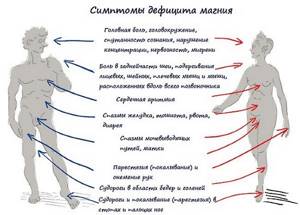
It is quite difficult for women to tolerate a lack of magnesium. In addition to irritability, fatigue, and headaches, which are a consequence of a lack of microelement, the lack of magnesium negatively affects a woman’s appearance.
From endless sleepless nights, your face turns pale and your hands often tremble. Lack of microelements leads to nervous and physical exhaustion during menopause in women.
Magnesium deficiency in children causes:
- severe cramps;
- colic in the abdomen;
- insomnia;
- reaction to noise;
- excessive physical activity.
Doctors strongly advise giving children more magnesium when consuming calcium.
Read the site’s popular article: Effective ways to boost an adult’s immunity at home.
Effect of magnesium
In the human body, magnesium functions as a kind of protective mechanism against attacks by infectious bacteria and viruses due to the reproduction of antibodies. Due to such properties as the production of the female hormone estrogen, ensuring the normal process of blood clotting and regulating the functioning of the entire body, magnesium is regularly prescribed to pregnant women. The main advantages of this microelement are:
- Normalization of the functioning of the human nervous system, due to the creation of stronger neural connections between fibers;
- Relieving muscle spasms;
- The presence of a slight vasodilator effect;
- Improving the process of absorption of nutrients by the gastrointestinal tract;
- Regulation of the bile excretion process;
- Reducing cholesterol levels in the body;
- Strengthening the human immune system;
- Preventive action against diseases caused by digestive disorders;
- Strengthening the heart muscle and blood vessel walls;
- Normalization of blood circulation, in particular, blood flow to the heart;
- Improving the color and condition of the skin;
- Removing inflammatory processes of the mucous membranes;
- Control and regulation of the amount of calcium;
- Serves as a kind of strengthening element for bones;
- Normalization of respiratory processes in diseases of the respiratory system;
- Brings noticeable relief from stress and depression.
In addition to the above advantages, magnesium is considered an essential microelement prescribed to patients with cancer. Also, due to its interaction with sodium and phosphorus, it helps to normalize the nervous and muscular functioning of a person.
If a deficiency of magnesium is detected, this provokes the removal of potassium from the organs at the cellular level.
By interacting with calcium and phosphorus, magnesium contributes to the formation of a stronger skeleton. If the microelement becomes insufficient and there is too much calcium, then the bones become brittle and the person becomes prone to osteoporosis. Magnesium also contributes to the synthesis of proteins and the transmission of hereditary genes.
Products containing magnesium in an easily digestible form

The first steps in the bioavailability of magnesium are mechanical chewing of food and exposure to stomach acid. After splitting, the mineral is well absorbed in the small intestine. There it passes from the “villi” to the capillaries, which are located in the small intestine. It is then absorbed in small quantities in the large intestine. Thus, complete absorption of the microelement in the body occurs:
- 40% of consumed magnesium is absorbed in the small intestine;
- 5% is absorbed in the colon;
- 55% remains in the body as waste.
Depending on the type of magnesium consumed and the person's health, these values may be higher or lower. Total micronutrient absorption is below 20% in some people. "Magnesium absorption" is a term used to refer to the entry of magnesium into the blood through mechanisms in the small intestine. Foods that may promote optimal mineral absorption:
- Fructose and complex carbohydrates;
- Protein, excluding unfermented soy products;
- Medium chain triglycerides such as: coconut oil and palm oil;
- Fermentable or soluble fibers, such as those from fruits and vegetables.
More interesting things
Morse is the best drink in the heat. It will cool you down and help your body
Foods that inhibit magnesium absorption:
- Insoluble fibers such as whole grains, bran and seeds;
- Foods high in phytates, such as whole grains and flours, bran, unsprouted beans and soybeans;
- Foods high in oxalates such as spinach, leafy greens, nuts, tea, coffee and cocoa. The listed products are characterized by a high magnesium content, but it is better to consume them separately.
Foods that contain high concentrations of fiber, phytic acid and oxalic acid help absorb magnesium. It is better to choose grains whose fibers contain a large amount of this substance. Grain fibers with low mineral content, as well as fresh bread and white flour, have less of it, which will hinder full absorption.



